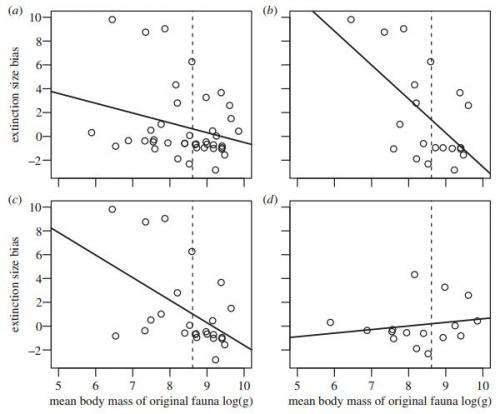April 2, 2014 report
Study shows medium-sized mammals may be more at risk of extinction than large or small species

(Phys.org) —A pair of researchers at Australian National University is suggesting in a paper they have had published in the journal Biology Letters, that in some instances, medium sized mammals may be more at risk of going extinct than larger or smaller species.
Scientists have learned over the years that larger animals are more at risk of extinction if environmental conditions change, than are those that are smaller than they are. Larger animals need to eat more to survive, they have fewer offspring and because they are bigger, they offer a bigger prize to predators. For all these reasons, larger animal populations tend to grow a lot slower than that of animals of smaller size. Because of that environmentalists have been focusing more on how to save larger animals in light of global warming. In this new effort, Emily Hanna and Marcel Cardillo wondered if perhaps things might change if predators are taken into consideration. To find out, they turned to a huge database that holds data on animal populations across 320 islands around the Australian continent. In all, they looked at 928 populations of mammals that included 100 different species.
In looking at the data, they found a pattern emerging—medium-sized mammal populations declined more rapidly than did bigger or smaller species when they served as the prey for fox and cats (larger animal populations declined faster than all other sized mammals when there were few to no predators). Thus, the team suggests, the general rule of larger animals declining faster may only apply if there are no predators taking big chunks out of medium-sized populations. Plotted out, they note, the data shows a hump shaped curve in extinction probability when predators are taken into account, because they tend to target medium-sized prey—smaller mammals are too hard to catch, and the larger ones are too difficult to bring down. The team's results are the first to link medium-sized mammals with an increased risk of extinction due to predation in a changing environment. Their study suggests, they note, that future efforts to protect endangered species take both size and predators into consideration.
More information: Predation selectively culls medium-sized species from island mammal faunas, Biology Letters, 2014. rsbl.royalsocietypublishing.or … ontent/10/4/20131066
Abstract
Globally, elevated extinction risk in mammals is strongly associated with large body size. However, in regions where introduced predators exert strong top-down pressure on mammal populations, the selectivity of extinctions may be skewed towards species of intermediate body size, leading to a hump-shaped relationship between size and extinction risk. The existence of this kind of extinction pattern, and its link to predation, has been contentious and difficult to demonstrate. Here, we test the hypothesis of a hump-shaped body size–extinction relationship, using a database of 927 island mammal populations. We show that the size-selectivity of extinctions on many islands has exceeded that expected under null models. On islands with introduced predators, extinctions are biased towards intermediate body sizes, but this bias does not occur on islands without predators. Hence, on islands with a large-bodied mammal fauna, predators are selectively culling species from the lower end of the size distribution, and on islands with a small-bodied fauna they are culling species from the upper end. These findings suggest that it will be difficult to use predictable generalizations about extinction patterns, such as a positive body size–extinction risk association, to anticipate future species declines and plan conservation strategies accordingly.
Journal information: Biology Letters
© 2014 Phys.org



















